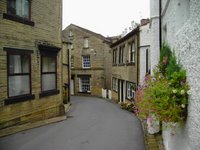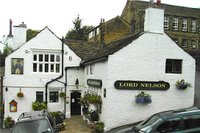

I’m currently living in the conservation village of Luddenden, amidst the very picturesque Pennine hills , in the northern area of the country. The little village itself dates back to Anglo-Saxon times, and the surrounding valley is full of history from the Middle Stone Age to the Bronze and Iron Age. Flints , tools & Celtic beads have all been found in the village. The village was historically centered around mills, with corn mills established in 1284. During the 15th century handloom weaving was established and in 1842 the first steam powered mill was built in the village. All the mills are gone now, converted into upscale flats. The village claim to fame now is winner of yorkshire in bloom, for its gardening feats.
As a lover of architecture and the personal mythology wrapped up in homes, I do enjoy this area as it reportedly has more 17th century houses than any other area of comparable size in the country. There’s also homes from the later half of the 19th century, built by wealthy mill owners. This village has some grand houses, and unfortunately we don’t live in one!
The heart of the village is the The Lord Nelson pub, built in 1634 and the oldest building here. And funnily enough, it sits across from the church and graveyard- which one can glean a lot of local history from. This general area, is known as Bronte Country, since the home of Charlotte & Emily is in Haworth, West Yorkshire, not far from here. The lesser known brother, Branwell Bronte, was the most famous customer of the pub.
Being from America (the new country), where buildings have a relatively short history, the age of the buildings here is amazing to me.. and the fact that so many are still standing, and standing in good shape. The stone holds a continous history and so many memories.
As a lover of architecture and the personal mythology wrapped up in homes, I do enjoy this area as it reportedly has more 17th century houses than any other area of comparable size in the country. There’s also homes from the later half of the 19th century, built by wealthy mill owners. This village has some grand houses, and unfortunately we don’t live in one!
The heart of the village is the The Lord Nelson pub, built in 1634 and the oldest building here. And funnily enough, it sits across from the church and graveyard- which one can glean a lot of local history from. This general area, is known as Bronte Country, since the home of Charlotte & Emily is in Haworth, West Yorkshire, not far from here. The lesser known brother, Branwell Bronte, was the most famous customer of the pub.
Being from America (the new country), where buildings have a relatively short history, the age of the buildings here is amazing to me.. and the fact that so many are still standing, and standing in good shape. The stone holds a continous history and so many memories.

No comments:
Post a Comment